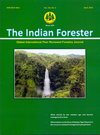Quantifying the Extent of Unsustainable Harvest of Fuelwood, Fodder and Non-Timber Forest Produce:Major Driver of forest Degradation in the Dry Deciduous Forest of Renukoot, Uttar Pradesh
DOI:
https://doi.org/10.36808/if/2016/v142i4/92301Keywords:
Drivers of Forest Degradation, Unsustainable Harvest, Sustainable Management of Forest, Sustainable Limit, Forest Biomass.Abstract
Forest degradation is a challenging issue worldwide, particularly in a country like India where forests are the major source of livelihood for millions of rural poor. But, over the years, forests are gradually degrading due to unsustainable harvest of fuel wood, fodder and Non-timber forest produce. The research study, aims to identify the major drivers of forest degradation in the dry deciduous forest of Gardarwa village forest of Renukoot forest division. Further, the study quantifies the extent of unsustainable harvest of fuelwood, fodder and other Non-timber forest produce in the study region and suggests ways to substitute them. Techniques such as coppice, pollarding, pruning, root suckers and trenching for sustainable harvest of forest produce are also recommended in the study to overcome the unsustainable extraction of Non-timber forest produce. The research study further estimates the potential forest biomass projection owing to the substitution of unsustainable harvest with alternative sources of livelihood and with adoption of sustainable techniques for the collection of other Non-timber forest produce in the Gardarwa village forest of Renukoot forest division in Sonbhadra district of Uttar Pradesh.References
Aggarwal A., Paul V. and Das S. (2009a). Forest resources: livelihoods, degradation and climate change in Green India 2047 renewed: looking back to change track, The Energy and Resources Institute,New Delhi, pp 91-108
Banerjee A. and Madhurima C. (2013). Forest degradation and livelihood of local communities in India: A human rights approach. Journal of Horticulture and Forestry, 5(8):122-129
Davidar P., Sahoo S., Mammen P.C., Acharya P., Puyravaud J.P., Arjunan M., Garrigues J.P. and Roessingh K. (2010). Assessing the Extent and Causes of Forest Degradation in India: Where do we Stand? Biological Conservation, 43(12):2937–2944.
GOFC-GOLD (2009). Reducing greenhouse gas emissions from deforestation and degradation in developing countries: a sourcebook of methods and procedures for monitoring, measuring and reporting. GOFC-GOLD Report version COP14-2, GOFC-GOLD Project Office, Natural Resources Canada, Alberta, Canada.
Herold M., Román-Cuesta R.M., Mollicone D., Hirata Y., Laake P.V., Asner G.P., Souza, C., Skutsch M., Avitabile V. and MacDicken K. (2011). Options for monitoring and estimating historical carbon emissions from forest degradation in the context of REDD+ Carbon Balance and Management, 6:13
Hosonuma N., Herold M., De Sy V., De Fries R.S., Brockhaus M., Verchot L., Angelsen A. and Romijn E. (2012). An assessment of deforestation and forest degradation drivers in developing countries. Environmental Research Letters, in review.
ICAR (1985). Nutrient Requirements of Livestock and Poultry in India. 1st edn. Indian Council of Agricultural Research, New Delhi.
IPCC (2006). Good Practices Guidelines for National Greenhouse Gas Inventories Switzerland: Intergovernmental Panel on Climate Change.
Kissinger G., Herold M. and De Sy V. (2012). Drivers of Deforestation and Forest Degradation: A Synthesis Report for REDD+ Policymakers. Lexeme Consulting, Vancouver Canada.
KrishnakumarJ.,Fox J. and Anitha V.(2012). Non-timber forest Products : Livelihoods and Conservation Economic & Political Weekly volxlvii 132-139
Lund H. (2009). What is a degraded forest. Gainesville, VA. USA: Forest Information Services; [http://home.comcast.net/~gyde/ 2009forest_degrade.doc].
Planning Commission’s Working Group on Forests & Natural Resource Management (2011). Report Of The Sub-Group II On NTFP And Their Sustainable Management In The 12th 5 Year Plan.
Saha D. and Sundriyal R.C. (2012). Utilization of Non-Timber Forest Products in Humid Tropics: Implications for Management and Livelihood. Forest Policy. Econ., 14:28-40.
Simula M. (2009). Towards defining forest degradation: comparative analysis of existing definitions. Forest Resources Assessment Working Paper 154 Rome, Italy: FAO; 2009.
Skutsch M.and Trines E.(2008).Operation alising reduced degradation within REDD. Policy Paper No.2: Kyoto: Think Globally Act Locally project.
UNFCCC (2008). Informal meeting of experts on methodological issues related to forest degradation. Chair’s summary of key messages. Bonn, October 20-21 2008.
Downloads
Downloads
Published
How to Cite
Issue
Section
License
Unless otherwise stated, copyright or similar rights in all materials presented on the site, including graphical images, are owned by Indian Forester.





